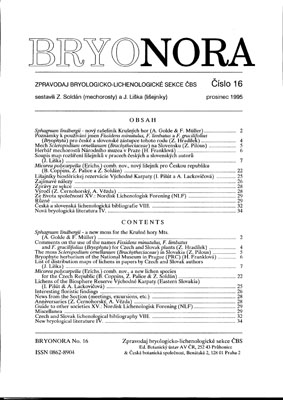

| Golde A. & Müller F.: Sphagnum lindbergii - nový rašeliník Krušných hor, 2–4 Sphagnum lindbergii - a new moss for the Krušné hory Mts. Abstract: Druh Sphagnum lindbergii Schimpl tx Lindb. byl autory příspěvku nalezen poprvé v Krušných horách, a to na rašeliništi Velké jeřábí jezero, v těsné blízkosti státní hranice s Německem. Dosud byl tento holarktický druh rašeliníku se subarkticko-subalpinským typem rozšíření znám z České republiky pouze z většího počtu lokalit v Krkonoších a jediné lokality v Jizerských horách. Přiložen je též fytocenologický snímek a poznámky k rozšíření tohoto druhu. Sphagnum lindbergii Schimp. ex Lindb. stellt eine aufgrund der gelbbraunen Färbung und die in der Spitze ausgefransten Stammblätter leicht kenntliche Torfmoosart innerhalb der Sektion Cuspidata dar. Im Mai 1994 fiel uns bei einer Exkursion im böhmischen Teil des Hochmoors Grosser Kranichsee (Velké jeřábí jezero) ein kräftiges, eine ganze Schlenke bestandsbildend ausfüllendes Torfmoos auf. Die mikroskopische Untersuchung des Materials zu Hause bestätigte die bereits im Gelände geäusserte Vermutung - es handelte sich um Sphagnum lindbergii |
| Hradílek Z.: Poznámky k používání jmen Fissidens minutulus, F. limbatus a F. gracilifolius (Bryophyta) pro české a slovenské zástupce tohoto rodu, 4–5 Comments on the use of the names Fissidens minutulus, F. limbatus and F. gracilifolius (Bryophyta) for Czech and Slovak plants Abstract: History and nomenclature of the names F. minutulus, F. gracilifolius and F. limbatus are discussed. The name F. minutulus has to be abandoned (nomen rejiciendum). The herbarium revision showed that in the territory of the former Czechoslovakia this name has been used for two different species. Most of the plants of the limestone rocks belong to F. gracilifolius (= F. minutulus auct. eur.); still, F. limbatus (= F. minutulus Sulk) was also confirmed for both the Czech and Slovak Republics (the Beskydy Mts., the Slovenský Kras Mts.). A determination key for the difficult group involving F. gracilifolius, F. limbatus, as well as F. viridulus is attached. |
| Pilous Z.: Mech Scleropodium ornellanum (Brachytheciaceae) na Slovensku, 5–6 The moss Scleropodium ornellanum (Brachytheciaceae) in Slovakia Abstract: The arctic-alpine moss species Scleropodium purum is recorded by the author from the Belianske Tatry Mts. (Tristarská dolina valley, calcareous rocks, ca 1900 m a.s.l.) in the Slovak Republic. Previously recorded occurrence of this species in Slovakia (Žmuda 1915) is erroneous (cf. Kuc 1956), |
| Franklová H.: Herbář mechorostů Národního muzea v Praze, 6–7 Bryophyte herbarium of the National Museum in Prague (PRC) Abstract: A brief history of bryophyte herbarium (including curators, main collectors) of the National Museum in Prague (PRC) is given. The herbarium contains ca 200 000 of specimens |
| Liška J.: Soupis map rozšíření lišejníků v pracech českých a slovenských autorů, 7–21 List of distribution maps of lichens in papers by Czech and Slovak authors Abstract: Index of lichen distribution maps in papers by Czech and Slovak authors comprises lichenological taxonomical and floristical papers as well as bioindication studies and manuscripts (theses). Therefore maps of former Czechoslovakia (CS), Czech (ČR) and Slovak (SR) Republics as well as regional maps are covered. Bibliographical citation includes page and data on type of maps (area: + means surroundings, B=dot map, S=grid map, x means change of distribution map) |
| Coppins B., Palice Z. & Soldán Z.: Micarea polycarpella (Erichs.) comb. nov., nový lišejník pro Českou republiku, 22–25 Micarea potycarpella (Erichs.) comb. nov., a new lichen species for the Czech Republic Abstract: A rare lichen species, previously known as Lecidea polycarpella Erichs., is reported for the territory of the Czech Republic for the first time. Until now, it has been collected in disturbed or urban habitats in Austria, Germany and Great Britain only. However, it is probably an overlooked species with a wider pattern of distribution. Due to a revised interpretation of the hvphae forming an "excipulum", now regarded only as remnants of the hyphal layer surrounding the apothecium in its initial (primordial) stages, and due to some other microscopical features (type of paraphyses and asci), it is transferred to the genus Micarea. New combination is as follows: Micarea polycarpella (Erichs.) Coppins & Palice. This species was discovered in a secondary habitat - graphitic slate (occasionally enriched by iron) or phvilite boulders (with quartz eyes) in sedimentation basin of the factory for processing of pyrite material and the power station near Chvaletice in central Bohemia. More detailed description of this lichen and its habitat (inclusive associated species) is given. |
| Pišút I. & Lackovičová A.: Lišajníky biosférickej rezervácie Východné Karpaty, 25–26 Lichens of the Biosphere Reserve Východné Karpaty (Eastern Slovakia) Abstract: Preliminary report on the lichen flora of the Biosphere Reserve Východně Karpaty (NE Slovakia), is presented. In total 208 species is recorded (62 of them belong among threatened). Several species very rare in other parts of Slovakia were found: Lecanora cinereofusca, Thelotremalepadinum, Lobariapulmonaria, Normandinapulchella Mencgaiziaterebrata Gyalectaflotowii, G. ulmi. Though suitable conditions for development of epiphytic and epixylic lichens (132 taxa) are still present in the Reserve, decrease of sensitive indicators of natural mountain forests is evident. |
| Anonymus: Zajímavé nálezy, 26–27 Interesting floristic findings |
| Hradílek Z. & Novotný I.: Zprávy ze sekce, 28–0 News from the section (meetings, excursions, etc.) |
| Anonymus: Výročí (Z. Černohorský, A. Vězda) , 28–28 Anniversaries (Z. Černohorský, A. Vězda) |
| Liška J.: Ze života společností XV.: Nordisk Lichenologisk Forening (NLF) , 29–29 Guide to other societies XV.: Nordisk Lichenologisk Forening (NLF) |
| Novotný I., Liška J., Váňa J. & Buryová B.: Různé, 29–32 Miscellanea |
| Liška J.: Česká a slovenská lichenologická bibliografie VlII., 32–34 Czech and Slovak lichenological bibliography VIII. |
| Soldán Z.: Nová bryologická literatura IV., 34–36 New bryological literature IV. |